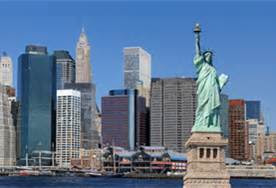INTRODUCTION
This post and the next is on
the topic of economic development and its contribution to economic growth. Since the beginning of the Industrial
Revolution more than 200 years ago, this is the central economic dynamic.
The following are factors that led to American economic
development, many in place before the beginning of the Industrial
Revolution. The United
States, more than any other country, was
positioned to take advantage of the new technology and ideas that were the
basis of the Industrial Revolution. The
following is an outline of those factors.
For the full story of the early decades of America's Industrial Revolution, see Engines of
Change and some of the excellent histories written about America
after the Revolution.
FACTORS IN AMERICAN ECONOMIC DEVELOPMENT AND
GROWTH
The usual narrative centers on the inventors and entrepreneurs
who developed and commercialized new production and transportation technology and technological
improvements. They also invented new
organizational structures to exploit the new technology, both on the supply and
demand side.
This post looks at contributing factors that made the
American experience exceptional. The United States
began innovation after England, the country that started the Industrial Revolution, but quickly caught up. By the mid-1800s, America has surpassed England in key technologies. Innovation has continued up to the
present. Why?
RADICAL POLITICAL, CULTURAL AND
SOCIAL CONDITIONS CONDUCIVE TO SUPPORTING THE INDUSTRIAL REVOLUTION
The United States
had developed social, political and cultural institutions that were supportive
of the market capitalism version of the Industrial Revolution before it began. Because of the American Revolution, there was
an aversion to a strong central government, which at the time was dominated and supported favored
pre-industrial classes or groups.
- No
rent-seeking (parasitic) royalty or nobility.
- No
state-supported church.
- Limits
on government-supported monopolies. (By rulings of the Marshall Supreme Court)
- No
guilds to retard innovation, factories and new forms of labor relations.
- A
Constitution giving the Federal government wide powers to support a
national economy and limiting states’ ability to "restrain" trade among states.
- A
culture emphasizing individual responsibility and individual opportunity.
- A
radical political system, a democracy based on universal white male suffrage.
- Wide dissemination of information among a literate public.
- A
mobile social system and open society that encouraged risk-taking.
ENGLISH LEGAL INSTITUTIONS, ESPECIALLY PROTECTION OF
PRIVATE PORPERTY, PATENTS, AND
ENFORCEMENT OF CONTRACTS
Strong English tradition of protecting private property
and enforcing contracts.
Underlying law and custom protecting the rights of
individuals.
Patent law to protect innovations.
ACCESS TO ENGLISH INDUSTRIAL TECHNOLOGY AND
APPLIED SCIENCE
England
was the first country to industrialize. Some
important aspects:
- Innovative
methods to smelt iron, increasing quantity and lowering unit cost.
- The application
of more efficient steam engines and water power to drive machinery. Beginning of factories. Large increases in quantity and reduction in unit cost.
- Steam engine power-driven
textile mills and then railroads.
- More
accurate machine tools to produce machinery and metal products.
- Tradition of entrepreneurs and innovative mechanics, machine tool makers and engineers
- Continuous invention and improvement; cumulative large increases in productivity.
Most of this technology, and the ideas behind them, were transferred
quickly to America,
changed to fit American conditions, and improved. Some transmission channels:
English immigrants.
An English immigrant named Samuel
Slater built the first water-powered cotton spinning mills.
Welsh ironmasters who knew how to
use anthracite coal to smelt iron.
Contacts with England,
both personal and scientific.
Imitating or
stealing English technology.
Francis Cabot Lowell and the
integrated, power-driven textile mill.
Steam engines and locomotives. Americans went to England
to study the English development of locomotives and railroad technology even
before the English built the first general-purpose railroad.
Within two years of the first
English railroad, Americans were importing English locomotives, adapting them
to American conditions, and manufacturing them.
Robert Fulton first learned about steamboats in England.
Access to English scientific and
technical publications.
Establishment of American
scientific societies to discuss new ideas and technologies, and disseminate the
knowledge.
HUGE NATURAL RESOURCES
In early decades, vast quantities of wood, iron ore, anthracite
coal, fast-flowing streams and rivers for water power.
The United States
would continue to be the world’s leading producer of almost all key minerals
and fossil fuels (coal, oil, natural gas) until after WWII.
Huge potential agriculture.
Development of commercial
agriculture, starting in colonial period.
Commercial production for market.
Surplus
food for industrial workforce.
Main
source of exports until 20th Century.
CONTINUING IMMIGRATION
In the colonial period and until 1860, slaves and indentured
servants produced most of America’s
exports that helped pay for the importation of European capital goods and
technology.
Over the last 200 years, there have been as many as 75
million immigrants. Immigrants have been
an important factor in American economic development from the very beginning.
Free human capital.
Mostly young adults. Much of the
cost of raising them to adults, their education and acquisition of knowledge
and skills paid before they came to America. Crucial “free lunch.”
Like Sam Slater,
many brought specialized skills and knowledge.
Disproportionate number of innovators and entrepreneurs.
Created
vast and growing internal market.
Early on, America’s
democratic ethos and the existence of an open society created opportunity for
advancement for lower-class mechanics and millwrights unavailable in England. They could become part-owners of new business
establishments based on their technical knowledge. This was the beginning of what I call the
“hustler and the nerd” model of economic innovation. From Samuel Slater and Amos Brown (cotton spinning) to William
Clark and Isaac Singer (Singer Sewing Machine) to Silicon Valley
(scientific and computer nerds and venture capitalists).
For the first 100 years of the Second Industrial Revolution (1870 - 1970), all industrializing societies, including America, ignored the "negative externalities." As had all societies before then. This meant the producers, distributors, and consumers did not have to pay the full cost of their activity. Some examples of negative externalities are destroying the natural environment (clear-cutting forests, water pollution, air pollution, dangerous and deadly work places, noise pollution, accidents and death (auto fatalities and injuries), terrible unhealthy slum living conditions). It was only with the exponentially cumulative effect of all negative externalities that governments began to deal with them.
CONCLUSIONS
In economics, Milton Friedman popularized the phrase “There
ain’t no such thing as a free lunch.” This
may be true in a closed economy but not in an open society like the United
States that allowed immigration, imported (stole) ideas and technology, and provided
the resources and opportunity to develop new technologies and economic
institutions.
A more formal phrase for a free lunch is “positive
externalities.” A positive externality
occurs when someone benefits from someone else’s actions without paying for
it. For the American private sector as a
whole over the last 200 years, there has been lots of free lunches.
Tens of
millions of young adult immigrants.
Brought
labor, skills, education and knowledge.
Access to
knowledge of foreign technology.
This combination reduced the cost and increased the speed of industrial innovation.
Immigrants, shut out of traditional and high-status careers,
look for or created new opportunities. They had to
be innovative but had opportunities for advancement not available elsewhere. A recent study concluded that immigrants are twice as likely to start new businesses than native-born Americans.
The point is that continual economic development depends on a country's political, cultural, and social institutions, not just on its economic institutions.
==================================================
A related post:
The Beginning of the Industrial Revolution in America
These posts on early American history give some detail on the factors discussed in this post:
For an excellent example of an entrepreneur at the beginning of the Industrial Revolution in England, see
Josiah Wedgwood, the Wedgwood Pottery Company, and the Beginning of the Industrial Revolution.
See related posts:
After reading this post, you might want to see the related post on the first case study of a source of economic development, Adam Smith's Pin Factory.
For the story of how England lost its economic leadership, see A Cautionary Tale: England and the Industrial Revolution










Comments
Post a Comment